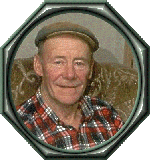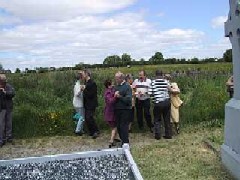![]() The main focus in their classes will be to emphasize regional styles and proper teamwork when dancing sets which some feel have become lost amid the enthusiastic and widespread response to set dancing everywhere. There is little to be gained by learning more and more sets if they aren't danced properly by the majority of dancers, no matter how much fun people are having.
The main focus in their classes will be to emphasize regional styles and proper teamwork when dancing sets which some feel have become lost amid the enthusiastic and widespread response to set dancing everywhere. There is little to be gained by learning more and more sets if they aren't danced properly by the majority of dancers, no matter how much fun people are having.
 Irish dancing is very much on the world stage today. It is presented with great professionalism, great flamboyance and great colour. We hear a lot today of schools of dancing and set dancing workshops, all of these are most enjoyable occasions and long may they continue. But I think one can never lose sight of one's roots and the true genius of a great artist like Willie Keane. Willie was a dancer's dancer, a superb artist that it would be almost impossible to emulate. The new trend in set dancing today is for dancers to know a great many sets and this is wonderful. But quality is all important and can never be overlooked for quantity. Willie Keane was a person who had quality in his superb dance. I think one of the great proofs of Willie's regard as a dancer is that the finest musicians in Ireland were always privileged to play for him. They felt that the music and the dance were at one when Willie was dancing. I refer to great Clare musicians such as Tony MacMahon, Noel Hill and Martin Hayes - every one of these are on record stating how much the great dancing of Willie Keane influenced them and how they were so honoured to play for him.
Irish dancing is very much on the world stage today. It is presented with great professionalism, great flamboyance and great colour. We hear a lot today of schools of dancing and set dancing workshops, all of these are most enjoyable occasions and long may they continue. But I think one can never lose sight of one's roots and the true genius of a great artist like Willie Keane. Willie was a dancer's dancer, a superb artist that it would be almost impossible to emulate. The new trend in set dancing today is for dancers to know a great many sets and this is wonderful. But quality is all important and can never be overlooked for quantity. Willie Keane was a person who had quality in his superb dance. I think one of the great proofs of Willie's regard as a dancer is that the finest musicians in Ireland were always privileged to play for him. They felt that the music and the dance were at one when Willie was dancing. I refer to great Clare musicians such as Tony MacMahon, Noel Hill and Martin Hayes - every one of these are on record stating how much the great dancing of Willie Keane influenced them and how they were so honoured to play for him.
The dancers were all beginners and eager to learn. My half-set was practicing the Christmas, and the other gent explained how to place the arms, "Left hand over, right hand under." As we started turning, I added, "Then lie back and think of Ireland," which I heard someone say last weekend in Newport.
Maybe we should all think a bit more about the 'quality' of dancing rather than the 'quantity' with its emphasis on the accumulation of sets above anything else. The pressure seems to be on to produce more and more new sets to keep dancers in a constant state of titillation, and always above their boredom threshold. As Helen Brennan points out there are still places in Ireland where all that is danced in a night and maybe ten times over is 'The Set'. Yet in no way is the enjoyment and pleasure diminished by doing 'the same old thing, again and again'.
 Betty McCoy officially opened the weekend [Connie Ryan Gathering, 11-13 June 1998, Clonoulty, Co. Tipperary] and she told some lovely personal stories about Connie. She revealed that we have Connie to thank for the Connemara set that we dance today. In Connemara it was danced as a half set in two figures, a long reel followed by the 'Maggie in the Wood' polka. Connie divided the reel into three figures, arranged it for tops and sides and added the lead around and circle which open them.
Betty McCoy officially opened the weekend [Connie Ryan Gathering, 11-13 June 1998, Clonoulty, Co. Tipperary] and she told some lovely personal stories about Connie. She revealed that we have Connie to thank for the Connemara set that we dance today. In Connemara it was danced as a half set in two figures, a long reel followed by the 'Maggie in the Wood' polka. Connie divided the reel into three figures, arranged it for tops and sides and added the lead around and circle which open them.
I would like to give some information on the origin of the Kilconly crossroads ceili, which as people could see on the website is not held at the crossroads anymore. From my research into this I have been reliably informed that approximately 100 years ago people from the surrounding villages would get to together at the crossroads one mile from where the open-air ceili is now held. Here there would always be a few musicians, the main instruments at the time would be the fiddle that musicians would make themselves and the melodeon, and there would be music and dancing into the small hours of the night. My source stated that this would not just be a yearly event as our crossroads ceili now is, but they would be held every week during the summer months and not on a plywood floor as ours, but on a sandy road.
One lady had an amusing way of remembering the fourth figure of the Lancers. When opposite couples lead around, "First you drive like the Irish, then you drive like the Americans," she said, meaning keep left the first time, and right the second.
![]()